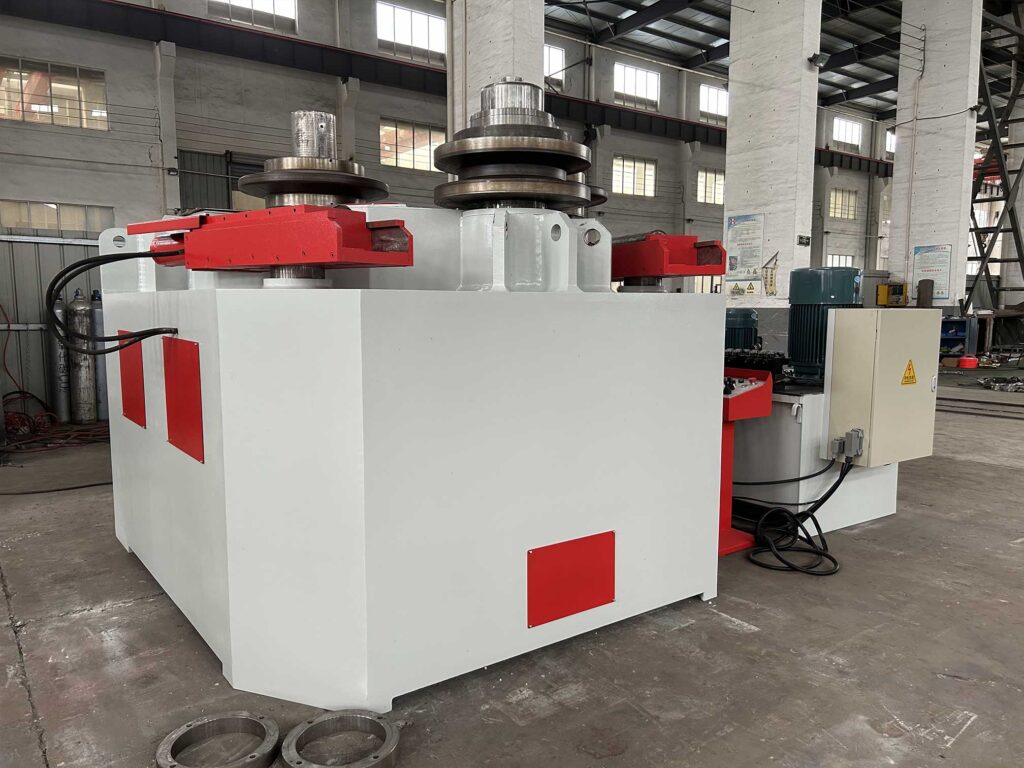The profile bending machine is a specialized device for bending angle steel, channel steel, I-beams, square steel, and other shaped metal profiles. Its primary function is to pre-bend the ends of profiles and complete pre-bending, rolling, and rounding processes in a single operation, thereby achieving full-profile bending and forming.
Features Of Profile Bending Machine
The
profile bending machine features a rational structure, stable performance, user-friendly interface, versatile functionality, high efficiency, and excellent forming precision. It is ideal for circular arc bending of various metal profiles such as aluminum and steel.
Depending on the material type, bending radius, and ductility of the profile, operators can choose either single-pass forming or multiple progressive forming methods to meet different processing requirements.
The machine adopts an arc downward-adjusting structure. The upper roller shaft remains fixed, while the two lower roller shafts move in an arc path around a central pivot relative to the upper roller. During operation, the two lower rollers not only provide guidance but also serve as the main drive shafts, directly powered by hydraulic motors. This mechanism gradually rolls and forms the bent profile step by step.
All machine motions are hydraulically driven. The lifting of the lower rollers is controlled by an integrated electrical system, allowing operators to monitor real-time data and make precise adjustments through the digital display on the control panel.
To prevent twisting or deformation during bending and to improve forming accuracy, the machine is equipped with two sets of vertically adjustable support rollers and guide wheels. These components flexibly adapt to various profile sizes and bending radii.
Profile Bending Machine:Operating Precautions
1. Pre-Startup Preparation
Equipment Inspection:
- Before starting the machine, check the hydraulic oil level and quality, and ensure there are no leaks.
- Tighten all fasteners such as bolts and nuts, and verify there is no looseness.
- Inspect all electrical wiring for damage and confirm reliable grounding.
- Ensure that buttons, switches, and indicator lights function properly.
- Check that all roller shafts—especially the upper and lower rollers—are correctly positioned and free of obstructions.
No-Load Test Run:
- After starting the machine, run it without load for one to two minutes and observe its operation.
- Let the upper slide plate complete two to three full-stroke cycles to confirm smooth motion without abnormal sounds or vibration.
- If you detect unusual noise, odor, vibration, or hydraulic leakage, stop immediately, locate the fault, and correct it before resuming work. Never operate the machine with existing faults.
2. Safety During Operation
Return-to-Origin Procedure:
- Perform the return-to-origin operation only when the upper slide plate and positioning axes are at their home positions.
- If they are not, manually reset them or use the control program to restore their positions before proceeding, ensuring accuracy and safety.
Control Operations:
- Control all actions through the main control panel. Do not modify control wiring or parameter settings without authorization.
- Closely observe both the deformation of the profile and the operational status of the machine. If abnormalities occur, stop the machine immediately.
Speed Control:
- Maintain proper bending speed to prevent tearing, excessive spring-back, or mechanical overload.
- When bending large angles or small-radius profiles, reduce the speed appropriately to ensure safety and forming quality.
3. Loading, Unloading, and Handling Workpieces
Designated Supervision:
- Assign a trained operator to oversee loading and unloading operations.
- Ensure all personnel maintain safe positions to avoid collision or compression injuries.
- Operate the pneumatic or hydraulic lift devices only after receiving clear instructions, and never activate them arbitrarily.
Workpiece Placement:
- Place workpieces neatly and securely according to designated layout requirements.
- Prevent rolling, slipping, or deformation.
- Never adjust or hold the profile by hand during operation to avoid injury.
Large-Radius Bending:
- When bending profiles with large curvature or small radius, operators and bystanders must stay clear of the profile ends to prevent injury from rebound or sudden movement.
4.Shutdown and Maintenance
Normal Shutdown:
- After completing processing, withdraw the profile, return the machine to its initial or safe position, and then shut off the hydraulic system and main power.
- Clean the equipment and workspace thoroughly to maintain tidiness.
Regular Maintenance:
- Inspect and service the hydraulic, transmission, and electrical systems regularly.
- Check the wear condition of rollers, support rollers, and guide wheels frequently, and repair or replace them when necessary to maintain forming accuracy.
Conclusion
The
profile bending machine is an essential tool for metal profile forming. With its robust structure and advanced hydraulic control system, it efficiently performs precise bending of various profiles. Operators must strictly follow the prescribed procedures to ensure safety, processing quality, and equipment longevity.
